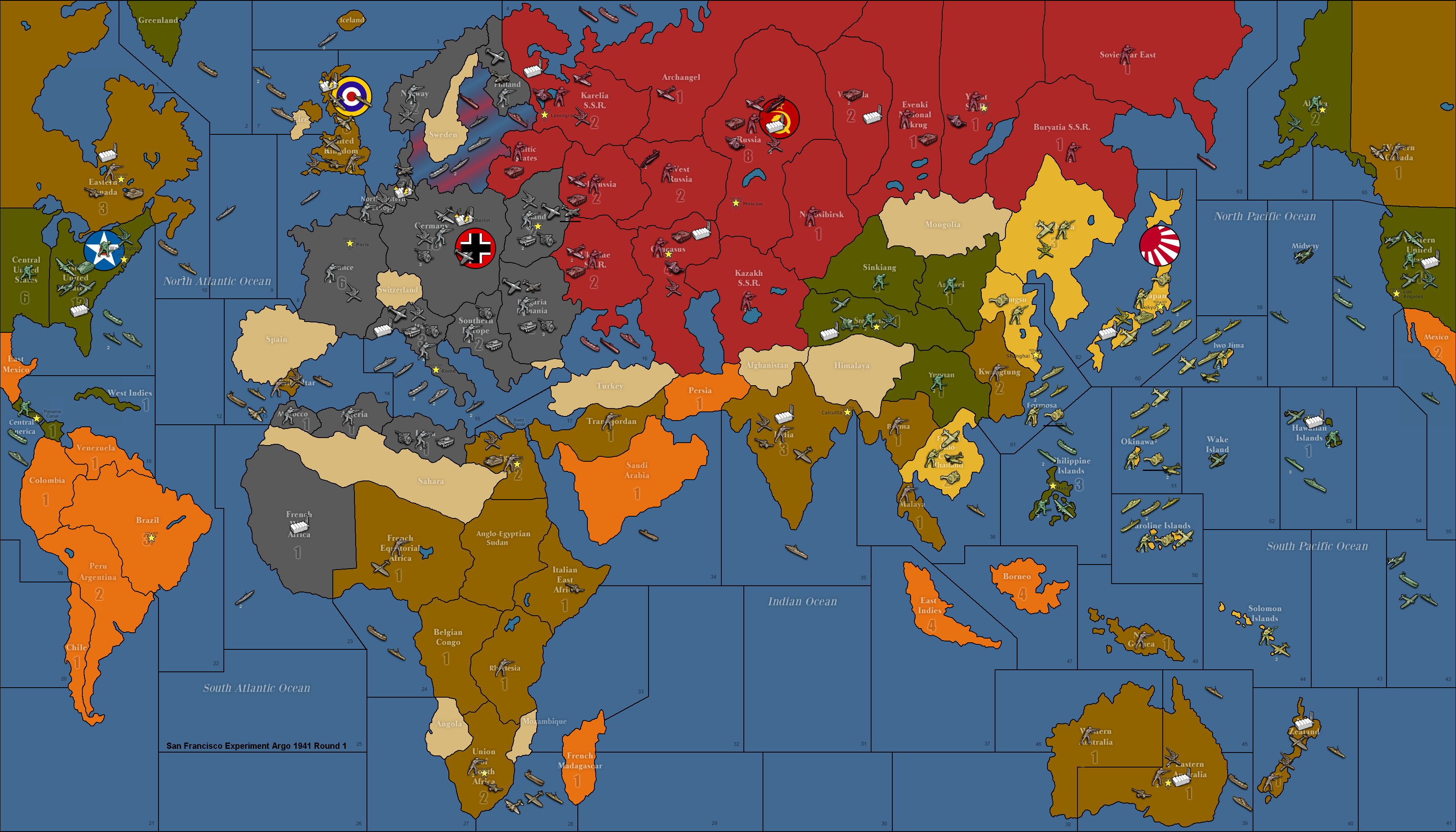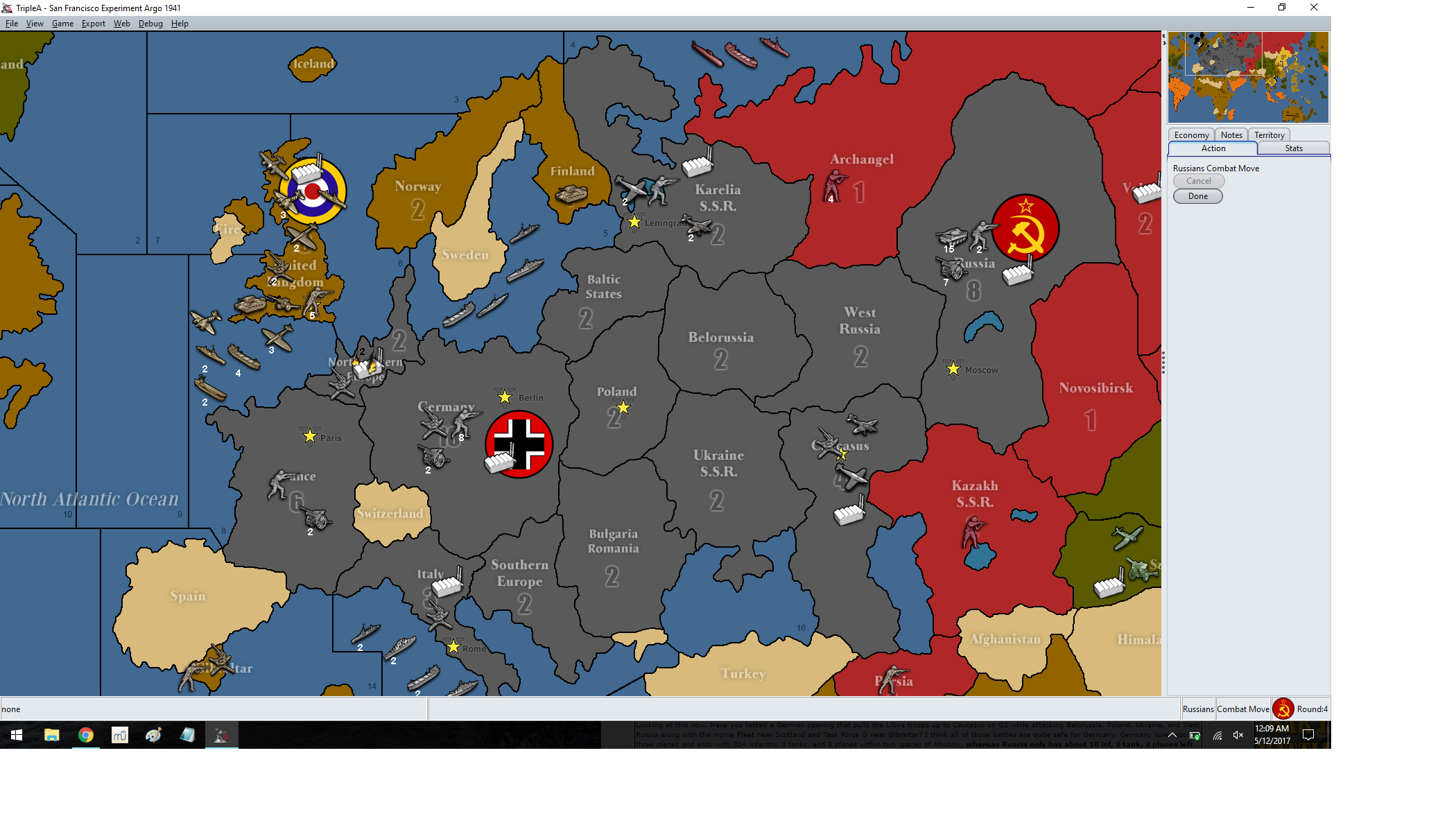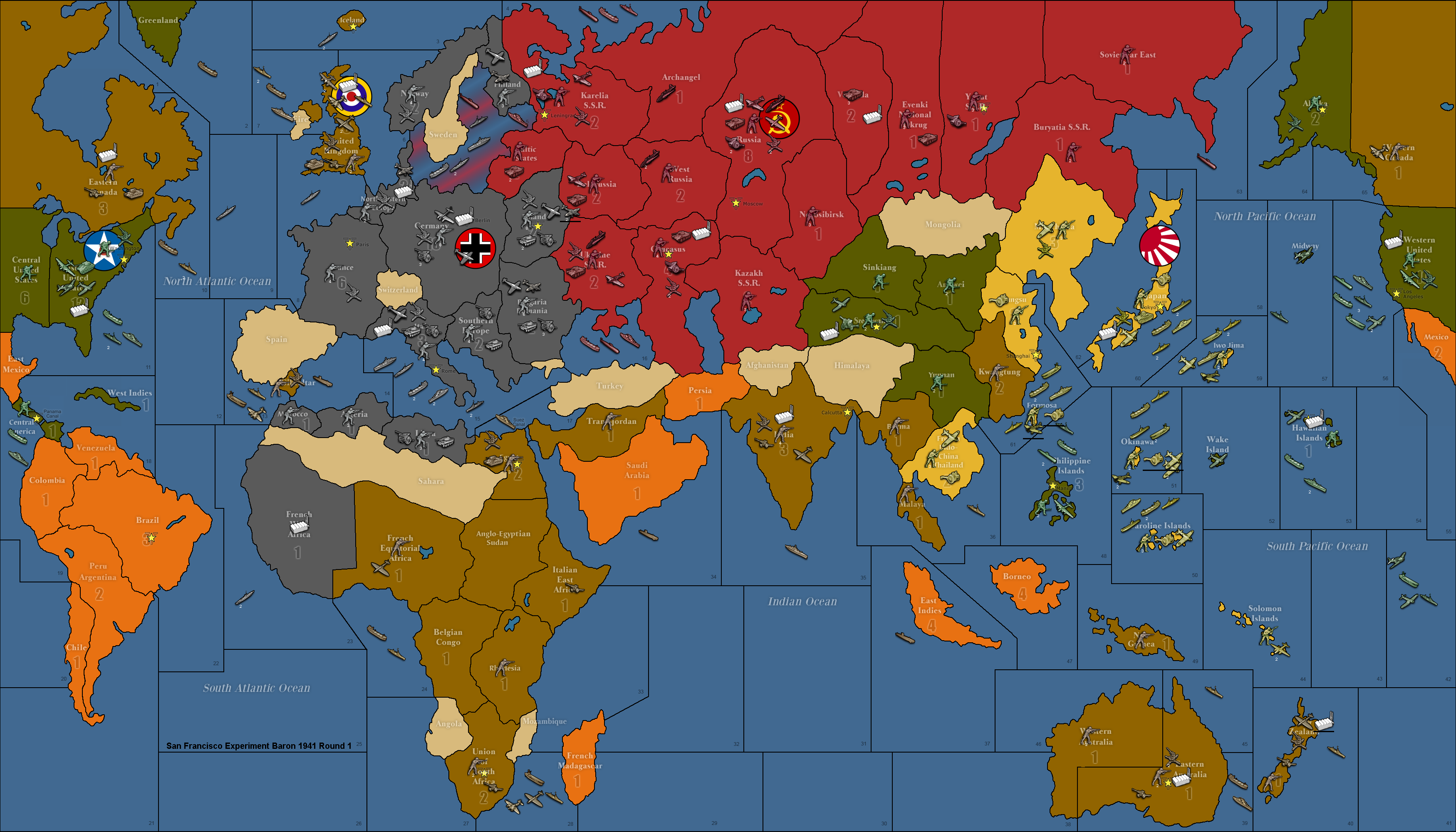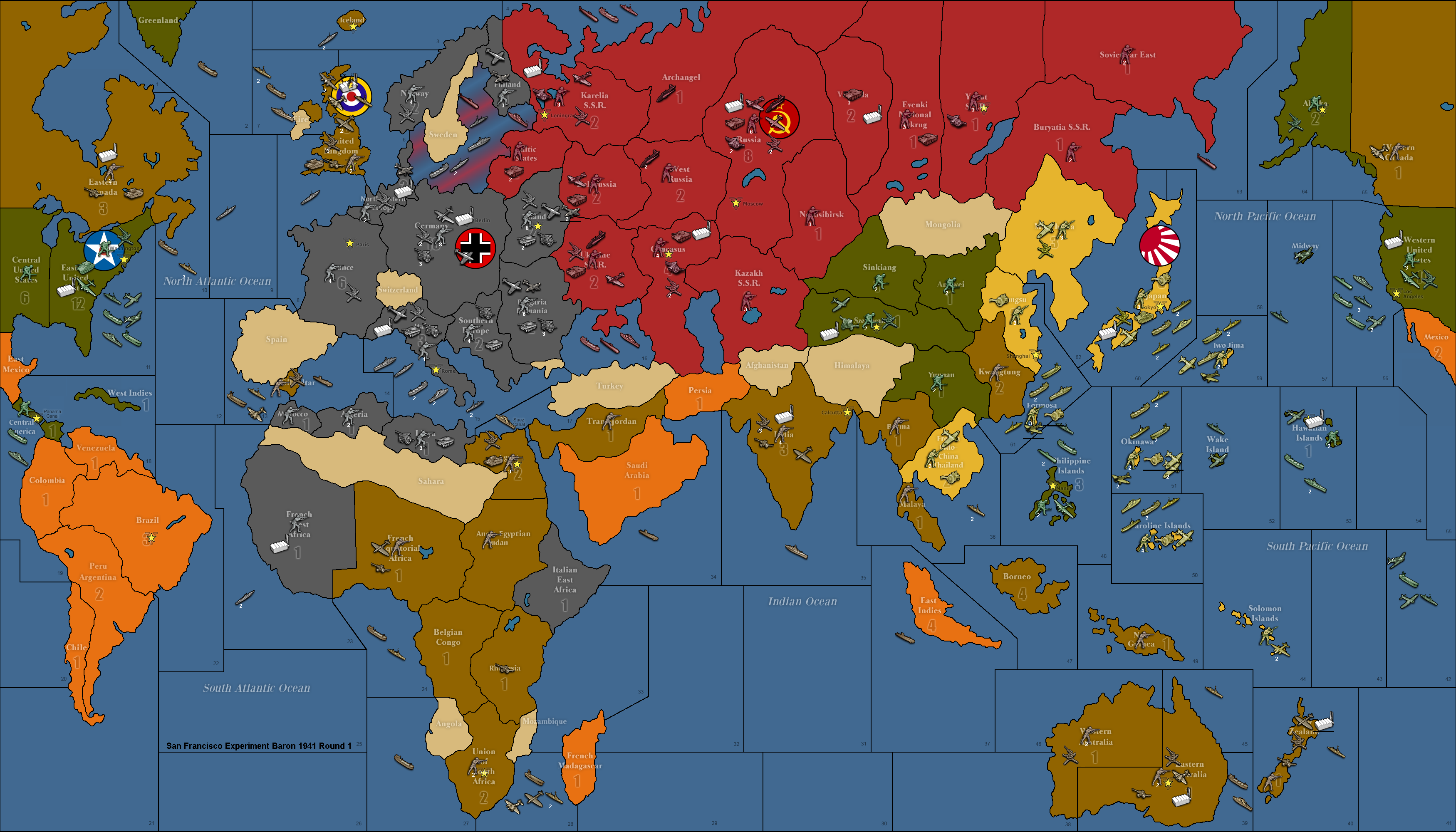@Argothair:
All right, that all makes much more sense – I’m sorry I criticized your methods so harshly. I am under some stress at work right now, and I may have been trying to take some of it out on you.
How Germany Can Expect to Win From 1941
In the 1942.2 OOB setup, Germany has 29 infantry and 3 artillery. Of those, Russia typically kills off 6 inf, 2 art (West Russia & Ukraine attack) before Germany even gets to move. So Germany will usually start G1 with 23 inf + 1 art = 24 walking units.
In your San Fran Alpha 0.5 1941 setup, Germany starts with 35 infantry and 6 artillery, and Germany gets to go first, so Germany will always start G1 with 35 + 6 = 41 walking units – almost twice as many walking units as the 1942 starting position.
Similarly, in 1942.2 OOB, Germany starts with 4 subs and 7 planes. It has two tiny fleets with one transport each, but they are very badly exposed, and Germany must take drastic measures to keep either of them alive until G2, let alone G3.
In SF Alpha 0.5 1941, Germany starts with 10 subs and 10 warplanes, plus a pair of reasonably well-protected fleets (BB + DD + tran in Baltic, BB + 2 CA + 2 DD + 2 tran in Med).
I think tanks come out roughly the same.
So Germany is “ahead” by about 180 IPCs’ worth of units in the 1941 setup relative to the 1942 setup. Yes, Germany has more tasks to accomplish (more British fleets to kill, more Russian fleets to kill, more Russian planes to kill, more Russian territories to take, etc.), but even allowing for serious losses (let’s say you lose 4 subs and 4 planes on G1 – that is a loss of $64) and even if it takes you 2 full turns just to get to the 1942 front lines (a loss of at most $10 on G1 and $5 on G2) that still leaves Germany well ahead of the game.
As you say, the Allies also have advantages…more starting troops in Africa, faster transports, a better-defended China, factories in ANZAC, etc. But Germany has enough “extra value” left over in its starting setup to have a fair shot at counteracting these advantages, I think.
Setting up tank battles
I did not fully understand this paragraph you wrote:
So, here is what I realized, if we want to convey the idea that Germany is a well prepared, well organized army, it should not be obvious to hard core player that you have to loose you costly units almost on starting G2 to make gains in Soviet union and more incomes. It is like you are fighting for 8 IPCs swing while you are wasting around 30 more or less IPCs TUVs to maintain your invasion in second row of TTs in Soviet Union. A bit unsound.
This sounds interesting. Can you say more about this?
In general, I approve of the idea of trying to show that germany was organized for war and russia was not. I am still unclear on how you want to do that, but I would like to learn more.
By the way, if you want to experiment with switching out many of germany’s tanks for extra infantry, we can explore that together – I have calmed down now and I can see why that would be interesting. We may decide to abandon that fork and go back to v5 or v6 or even earlier, but I do think it’s worth at least testing a version of that. I may try to create a radically new setup myself along those lines, that you can test if you wish.
I’m glad you like the idea: Germany organized, Russia not.
If you want to create the V7 setup, I would be very grateful because I will not have much time until Saturday.
Thanks for really make the count on Germany numbers.
I never thought there was that much Infantry.
If Japan do not invade it, Soviet Union will get probably more or less: R0 32 PUs, R1 26 PUs, R2 24 PUs, R3 17 PUs.
So, by R4 there will be near 100 PUs of unit added on board to resist Germany.
It means, around 30 Infantry to oppose German army in Soviet Union to added to Soviet units in Karelia, Caucasus and all TTs around Moscow.
This may help find the level of defense which Germany have to fight.
About what I said more or less correctly, I meant that the best offence, which doesn’t need to wait for slower fodder to catch frontal units to attack the next row of TTs in Soviet, is mainly built of Infantry and a few Artillery. If you can always wipe the enemy in a single combat round, you minimized damage on your side (here what are useful planes and Tank).
Eventually, all your Infantry units will wear off and Tanks / Artillerys will be exposed to attrition attack (strafing strategy) or an annihilation battle reducing as much as possible German offensive power. But what Russia will built, will be available next round to fight. Not the case for Germany, unless TP being short cut (Med fleet) or purchasing planes.
The minimal to win is to have a last tank to capture Moscow, while all your aircrafts and all fodders will be destroyed.
Until you get to Moscow, as long as Soviet have enough Infantry (with air support), he will trade German’s Art and Tank for a profit.
This is the general dynamics, like a wave on the shore which finally breaks at the end.
What is the key against Russia is to oppose an Infantry stack defending @2 against russian Infantry attacking @1. In such case, battle will be difficult but TUVs swing at best will be even. Usually when this happen, I have to fall back one TT with Russia until I get enough Infantry in my stack (combined with all planes and Tanks) to make some strafing (in hope that my big hitter will hit the mark on first combat round) then retreat. If there is no opportunity to have more russian Infantry than German in a given TT, I will have to take a defensive stance and reinforced if I can no more retreat.
Germany have three zones to fill with units: north, centre and south. This also reduces the main stack of German’s Infantry (because you will not expose a single Tank in a TT, if you have other means to control it).
Destroying German’s artillery and Tank and loose Soviet Infantry is the main objective for Russia.
As long as German’s army have a lot of fodder, Germany can marches on toward Moscow. Then, have to stop to replenish his front, then continuing with the new influx of Infantry.
It is at this condition, than a final showdown with Russia will be a real conquest (if Germany only loose Infantry and keep intact his Tank and planes).
My paradigm shift is to give minimal Tank and Arty on start but a lot of Infantry. Reinforcement will follow, if Germany purchase more Tank and planes.
For example, let’s suppose for G1 and G2, the main issue for Germany is to decide where to give support with Tank and Art.
In the worst case, he may have to rely upon planes to reach a maximum punch to limit the number of defending round and rolls.
However, Infantry attack rolls are less reliable and the more there is combat round, the more you loose attacking units. (Japan in Kiangsu against Anwhei can provides the model I got in my mind.)
From another aspect:
To make things more interesting as purchaser for Germany, you will prefer to have to buy warships, Art, Tank or planes.
This is only possible if you have a lot of Infantry but lacking of heavy hitter to support these units you will buy them to increase your attack factor for your Infantry.
I don’t think I’m very clear. I got the intuition but I need more time to get familiar with this idea and be able to better understand and explain it.
P.S. I see no offence, our method sometimes use pictures instead of more words. And without enough infos about intents and other reasons to put something here or there, it can be irritating.









